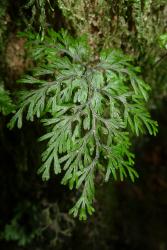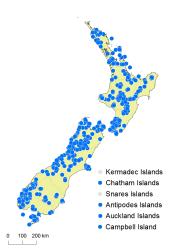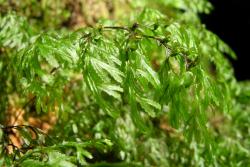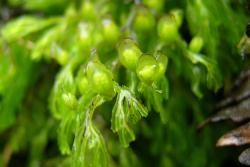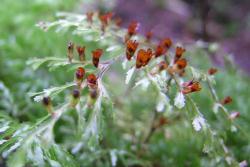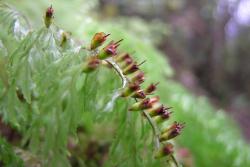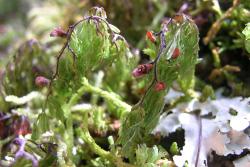- ≡ Trichomanes multifidum G.Forst., Fl. Ins. Austr. 85 (1786)
- ≡ Davallia multifidum (G.Forst.) Spreng., J. Bot. (Schrader) 1799(2): 271 (1800)
- ≡ Meringium multifidum (G.Forst.) Copel., Philipp. J. Sci. 67: 44 (1938)
- = Hymenophyllum truncatum Colenso, Trans. & Proc. New Zealand Inst. 23: 390 (1891)
- ≡ Hymenophyllum multifidum var. truncatum (Colenso) Domin, Biblioth. Bot. 20(85): 25 (1913)
- = Hymenophyllum alpinum Colenso, Trans. & Proc. New Zealand Inst. 31: 263 (1899)
- ≡ Hymenophyllum multifidum var. alpinum (Colenso) Domin, Biblioth. Bot. 20(85): 25 (1913)
- = Hymenophyllum oligocarpum Colenso, Trans. & Proc. New Zealand Inst. 31: 264 (1899)
- ≡ Hymenophyllum multifidum var. oligocarpum (Colenso) Domin, Biblioth. Bot. 20(85): 25 (1913)
Epiphytic, terrestrial or rupestral ferns. Rhizomes long-creeping, 0.2–0.5 mm diameter, bearing red-brown hairs up to 1 mm long, clustered at bases of stipes, scattered elsewhere. Fronds 13–380 mm long. Stipes 5–150 mm long, dark brown throughout, not winged or occasionally with a narrow wing in the distal half, bearing scattered hairs. Laminae usually 4-pinnatifid or rarely 3-pinnatifid or 5-pinnatifid, ovate or elliptic or triangular or broadly ovate, 8–225 or very rarely to 280 mm long, 7–120 mm wide, dark green, membranous, glabrous or with a few scattered hairs on the costae. Rachises winged throughout, dark brown or red-brown, glabrous or with a few scattered hairs; rachis wings planate or occasionally slightly flexuouse, margins toothed. Primary pinnae in 5–20 pairs, overlapping, winged throughout; distal portion of primary pinnae straight or incurved acroscopically; distal primary pinnae narrowly ovate or ovate or elliptic, adnate; proximal primary pinnae narrowly ovate or ovate or broadly ovate, adnate or occasionally the basal pair of pinnae almost stalked; the longest primary pinnae at or near the base, 4–120 mm long, 2–35 mm wide. Secondary pinnae arising both acroscopically and basiscopically, overlapping, winged throughout, adnate; narrowly ovate to narrowly elliptic on distal primary pinnae, ovate or narrowly ovate on proximal primary pinnae; the longest secondary pinnae 6–30 mm long, 4–15 mm wide. Ultimate lamina segments oblong or linear, up to 5 mm long, 0.4–1.3 mm wide; apices obtuse or truncate; margins toothed, lacking a distinct border; distal segments on primary pinnae curved towards frond apex. Sori borne on short acroscopic and basiscopic segments in proximal half of primary pinnae, solitary, 1–many on each primary pinna, adnate; indusia bivalvate, fused into a tube in proximal half, usually bent upwards at 90º to plane of frond; indusial flaps elliptic or obovate, 2–4 mm long, apices obtuse or truncate, margins entire or shallowly toothed; receptacles exserted up to 6 mm.
Hymenophyllum multifidum is usually a medium-sized filmy fern, but varies considerably in size from small forms at high altitudes or in the far south of the country, to much larger plants in high rainfall areas of the west coast of the South Island. It is distinguished by its generally glabrous or sparsely hairy fronds, toothed margins, and large sori which are bent upward at right angles to the plane of the frond and have the receptacle exserted for a distance similar to the length of the indusial flaps. Plants in the far south of the South Island and on the subantarctic islands tend to have more divided fronds with narrower ultimate segments, slightly hairier laminae, and longer hairs on the rhizome compared to those further north. Hymenophyllum multifidum is a very tolerant and widespread species, growing best in damp areas, but curling tightly when dry.
Sterile fronds are hard to distinguish from those of H. bivalve. However, H. multifidum generally has laminae which are slightly smaller, often obviously curled downwards, and have more pronounced teeth, especially on the rachis wings.
North Island: Northland, Auckland, Volcanic Plateau, Gisborne, Taranaki, Southern North Island.
South Island: Western Nelson, Sounds-Nelson, Marlborough, Westland, Canterbury, Otago, Southland, Fiordland.
Chatham Islands, Solander Island, Stewart Island, Antipodes Islands, Auckland Islands, Campbell Island.
Altitudinal range: 0–1800 m.
Hymenophyllum multifidum occurs in lowland to subalpine areas throughout the North Island from Doubtless Bay southwards. It is rarely found below 120 m, but extends up to 1400 m on Mt Hikurangi and in the Kaimanawa Ranges, and to 1600 m on Mt Ruapehu. In the South Island it occurs in lowland to alpine areas in all but the driest regions. It ranges from sea level to 1800 m in the Malte Brun Range, Mt Cook National Park. It is found on Solander Island, Stewart Island and all the subantarctic islands except the Snares Islands, reaching 450 m on Campbell Island. It has one of the largest altitudinal ranges of any New Zealand fern.
Also Lord Howe Island, Vanuatu, Fiji, Samoa.
Occurs in a wide variety of habitats from kauri, podocarp, beech and broadleaved forest, to mānuka, kānuka, Olearia and Dracophyllum scrub, subalpine herbfield and tussock grassland. It grows on the ground, in boggy areas, on humus hummocks, Sphagnum, rocks, scoria, banks, cuttings, in rock crevices, on rotten stumps and logs, and at the base of trunks. It also grows epiphytically on a wide variety of trees, including Beilschmiedia tawa, Coprosma rugosa, Dacrycarpus dacrydioides, Dacrydium cupressinum, Dracophyllum filifolium, Elaeocarpus dentatus, Ixerba brexioides, Knightia excelsa, Metrosideros umbellata, Olearia colensoi, Prumnopitys ferruginea, Weinmannia racemosa and species of Nothofagaceae. Unusually for a species of Hymenophyllum, it is rarely found on tree fern trunks except on the Chatham Islands where is has been recorded from Dicksonia squarrosa.
n = 26 (Brownlie 1954).



